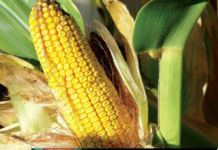Contact: Marsha Boswell, [email protected]
For audio version, visit kswheat.com.
Rain doesn’t fall often in Sherman County, Kansas, so farmers like David Leonard have learned how to improve yields by optimizing crop rotations, taking advantage of the moisture that does come and supplementing what Mother Nature doesn’t provide through irrigation. That combination of practice and luck is Leonard’s not-so-secret to winning the top spot in Kansas for irrigated winter wheat in the 2022 National Wheat Yield Contest with an entry of nearly 120 bushels per acre.
Leonard’s operation near Goodland is a diversified operation with a mix of dryland and irrigated acres in addition to a small cow-calf operation. Encouraged by his PlainsGold seed rep, he entered the yield contest for the first time in 2022. His entry came from a field planted to certified seed wheat that followed pinto beans, which provided some moisture profile.
“Our soil will hold about 1.8 inches of moisture per foot,” Leonard said. “So, if we have six feet of subsoil, we have some gas in the tank. We had some of that last year, but we don’t have that this year.”
From planting until harvest, the field only received 6.2 inches of moisture, so Leonard pumped another 10 inches of water to help the wheat crop along. He also furtigated nitrogen through the pivot to further boost yields. The widespread drought conditions last growing season meant it was too dry for even the weeds to grow, so he did not apply any fungicide.
“We didn’t use any fungicide because there was no green bridge to get stripe rust up here from Texas,” Leonard said. “When you’re that dry, you don’t have those issues.”
Closer to harvest, he applied a growth regulator. But, two days later the weather turned very hot, negating the application’s effect.
“It got really hot, so the growth regulator probably wouldn’t have been necessary because the wheat progressed really fast,” Leonard said. “Normally when you get these kinds of yields, the wheat is pretty tall and trying to lean over pretty hard.”
In the end, the plot of Langin yielded 119.57 bushels per acre. Leonard said he might have been even higher, but one of the few rain showers that the crop did receive came during harvest, which lowered test weights slightly.
But the result was an award-winning entry in the National Wheat Yield Contest, and, even more importantly, he sold the whole field for certified seed, so last year’s wheat harvest was a success.
What will this year’s National Wheat Yield Contest bring? That’s largely up to Mother Nature but follow Kansas Wheat to learn more about how Leonard and other Kansas winners selected varieties and took advantage of limited rains to maximize yields.
Producers can also check out Wheat Rx, a partnership between Kansas Wheat and K-State Research and Extension to disseminate the latest research recommendations for high-yielding and high-quality wheat to Kansas wheat farmers. Wheat Rx is a series of Extension publications and other educational outreach designed to address key management areas of hard winter wheat. These publications contain recent data based on novel research funded in part by wheat farmers through the Kansas Wheat check-off.
Check out the latest recommendations at kswheat.com/wheatrx.
###
Written by Julia Debes for Kansas Wheat




